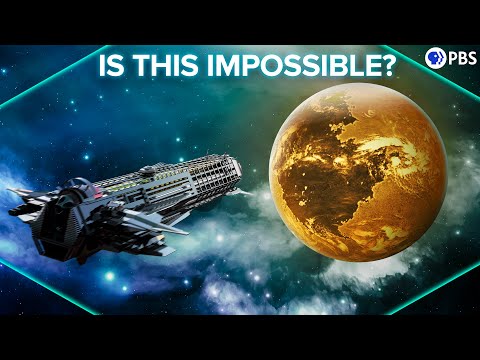Is Interstellar Travel Impossible?

Space is pretty deadly. But is it so deadly that we’re effectively imprisoned in our solar system forever? Many have claimed this is the case, but a few scientists have actually figured it out. Ever since Enrico Fermi asked his famous question “Where is everybody?” We’ve pondered the mystery of the Fermi Paradox. In a galaxy where billions of planets have had billions of years to spawn technological civilizations, why don’t we see any evidence of those that came before us? There are many possible answers to this, varying from the uplifting - like the idea that we are among the first to overcome some extreme evolutionary challenges - to the horrific - like the prospect that every civilization reaching our level of advancement subsequently annihilates itself. We’ve mentioned all of these before. But there’s very commonly cited explanation that we’ve never explored.
It’s perhaps the most boring explanation possible. We’ve avoided it because, frankly, I don’t want it to be the real answer to the Fermi paradox It’s the idea that we don’t see aliens because interstellar travel is just way too hard for anyone to bother. Technological civilizations like our own may rise and fall, some may reach heights of sophistication and advancement far exceeding our own. But none ever manage to populate the galaxy because sending living creatures between the stars is so difficult that it’s just not worth it. So today we’re going to explore this question - is humanity doomed to spend the rest of our species’ lifespan huddled in our own solar system? There are two factors that make interstellar travel difficult.
The first and most obvious and the one you already know about is also the most solvable. That’s the absurdly large distances involved. The nearest star, Proxima centauri, is 4.2 light years away. It would take the fastest spacecraft we’ve ever built - that’s the 163 km/s of the Parker solar probe - over 7000 years to reach Proxima, if it were even going in the right direction. For humans to travel the stars, travel time needs to at least be of order a human lifetime, which means traveling at relativistic speeds - sizable fractions of the speed of light. But this is actually a solvable problem.
The Breakthrough Starshot program proposes to send a train of tiny craft powered by solar sails, which would be accelerated to 20% light speed by a giant array of lasers back on earth. These craft are little more than computer chips, and sending humans means many orders of magnitude more mass for life support and shielding. But there are proposed advanced forms of propulsion that could in principle accelerate a proper spacecraft to a fair fraction of the speed of light. For example, really REALLY big light sails, or compact fusion drives, or matter-antimatter engines.
Some of these may be achievable in the distant but foreseeable future. The issue of the crazy distances should be completely solvable … if it weren’t for the second problem - which is that that interstellar space wants to murder us. ISM is the official acronym - not interstellar murder, but interstellar medium. The space between the stars in our galaxy is far from empty.
It’s filled with diffuse gas and dust grains. This stuff may be sparse, but at relativistic speeds every molecule becomes a tiny bullet. And that’s to say nothing of cosmic rays - particles moving fast enough to kill all on their own.
This is the number one potential dealbreaker for our future as a galactic species. Our glorious star-spanning future depends on the answer to a rather mundane question: can a ship large enough to carry humans be adequately shielded from tiny particles without adding so much extra mass that accelerating such a ship becomes a practical impossibility. And if the answer is no, have we solved the Fermi paradox in the least interesting way possible? Is the answer to Enrico Fermi’s question, “where is everybody?” may simply be “everybody stayed at home.” To figure this out, let’s design the most plausible crewed interstellar mission we can imagine. We’re going to send a starship to the Proxima Centauri with the aim of getting them there in a generation, and hopefully alive.
We’ll be using a propulsion system that can accelerate us to 20% of the speed of light. How far do we get before we’re obliterated by tiny space junk? Well, At 0.2 c, an encounter with a grain of dust around a millimeter wide delivers a few hundred million joules of kinetic energy. It vaporizes our ship instantly. So do we not even make it out of our solar system? Well, maybe not.
These sort of micrometeorites are somewhat common within the solar system - leftovers from the formation of the planetary system. This impact probability is way too high to be acceptable. Fortunately, micrometeoroid abundance drops dramatically as we leave the solar system.
So maybe we punch straight up out of the solar system to avoid the much higher density of junk in the ecliptic plane - and maybe we blast a path ahead with lasers or something from Earth. Then we angle towards Proxima Cen and and see how far we can get into the 20+ year journey we manage before we get roasted. To figure this out, let’s go over what the interstellar medium actually looks like. It’s 99% gas by mass and 1% very tiny dust grains.
That gas is around 90% hydrogen, and most of the rest is helium with traces of heavier elements The average gas density through the Milky Way disk is around 1 atom per cubic centimeter, however the Sun is in an under-dense region called the local bubble. It was probably created by a past supernova explosion. Around these parts there’s on average one atom per 10 cm cube.
The dust consists of silicate and carbonaceous molecules that have clumped together into grains. This stuff comes from heavy elements that are fused in the cores of massive stars and ejected in supernovae or in the winds from giant stars. These elements find each other and form molecules, and the molecules then clump together into grains. Most of these grains are between a tenth to a few tenths of a micrometer across.
Grains larger than this are exceedingly rare outside of planetary system. So rare that we get to pretty much ignore the possibility of a single grain destroying our ship. Even the smaller grains are sparse, at around 1 grain per 100-meter cube. So both the gas and the dust are diffuse, but remember, we’re traveling 4 light years. That means we’re guaranteed to hit a lot of the stuff.
None of those impacts are going to wipe the ship, but that may not matter. Think about a satellite or meteoroid entering the Earth’s atmosphere. They start to burn up almost as soon as they enter its upper layers, where the air is only a millionth the density of sea-level. That’s because these objects are traveling anywhere from several to several tens of km/s. And that’s the speed of impact with every air molecule, and so a lot of kinetic energy gets dumped into the falling object, usually destroying them before they hits the ground.
Interstellar space is quite a bit less dense than the upper atmosphere - by a factor of around 10^16. But we’re also traveling around 10,000 times faster than a re-entering low-earth-orbit satellite. So how quickly do we burn up at 0.2c? The kinetic energy deposited by each particles is 1/2 times mass times velocity squared.
Factoring in the relative densities, particle masses and speeds, the heat deposited onto our ship by the ISM is around a billion times lower compared to orbital re-entry. So it sounds like we might be OK with moderate shielding and heat dissipation. But there’s another issue. At these speeds, every single impacting atom or molecule can cause damage.
In a 2016 paper, Thiem Hoang and collaborators calculated the damage by individual particle impacts. They figure that the light hydrogen and helium don’t do lasting damage - they just deposit heat. But each impact by a heavier elements leaves permanent scars, with the relatively common oxygen and extra massive iron adding up to most of the damage. Traveling to Alpha Cen at 0.2c results in our forward hull being vaporized. But only to a depth of half a millimeter or so.
The damage due to dust impact is similar, with much of the forward surface area getting vaporized or eroded by tiny impact craters down to around a millimeter depth every 4 light years. So you DO need a bit of a shield, but not a crazy thick one, and only on the front of the ship. A windshield, in fact.
So we can minimise the additional weight by making our starship as long and narrow as possible. The Hoang paper wasn’t actually focused on the viability of crewed missions, but rather on missions like Breakthrough Starshot where the “spaceship” is a wafer-thin chip for which a millimeter ablation is significant. It turns out that for the sorts of missions that might possibly happen in our lifetimes, our entire payload could be destroyed by gas without at least some shielding.
OK, so far interstellar travel is sounding plausible, at least in terms of the ship surviving the journey. Moderate shielding is sufficient for nearby stars, and the ability to repair shielding might get us to more distant parts of the galaxy. There are more advanced options for the latter - for example, deflection of grains by magnetic fields or a shielding mass moving in front of the ship.
But to begin our interstellar adventure we don’t need anything too advanced. But there is a more subtle hazard. One that could result in our starship reaching its destination perfectly intact, but carrying a dead crew.
That hazard is radiation. While the ship’s hull will stop heavier elements in less than a millimeter, the hydrogen atoms can penetrate an order of magnitude deeper. Such atoms will be stripped of their electrons to become high-energy protons, in other words, they become radiation. In a 2006 paper, Oleg Semyonov calculated that the crew of an inadequately shielded ship at any relativistic speed would be subjected to levels of radiation comparable to the core of a nuclear reactor. Needless to say, this is instantly lethal for any living organism. A titanium windshield a centimeter or two thick should be enough protection against this radiation at 20% c, as would be a shield of water a meter thick - perhaps the best option because you’re carrying that water anyway.
You also need an inner layer of lead or similar to block the secondary radiation. If you want to travel at speeds closer to that of light, you need up to several meters of titanium or tens of meters of water. At any relativistic speed, spacewalks outside the ship are out of the question.
But none of this helps against the other type of radiation - cosmic rays. Interstellar space is flooded with high energy particles, from simple protons to massive iron nuclei. These things are accelerated in the monstrous magnetic fields of black holes and supernovae and of the galaxy itself. That radiation dose from cosmic rays is lower than that of the interstellar gas - it’s not instantly lethal, but will significantly increase cancer risks over our 4 year journey. However it’s harder to protect against cosmic rays because they hit the ship from all directions.
If you manage to accelerate to 80 or 90% light speed then most of the cosmic rays will hit from in front, and then your windshield protects you. But at more plausible speeds the ship will need shielding on all surfaces. A meter-thick shell of water around the entire ship would do the trick, but would add a prohibitive mass - too much to accelerate txo relativistic speeds, at least for our early iterations of starship propulsion technology. Most likely the first generations of interstellar travelers will have to accept the health risks and hope that the destination is worth it.
For interstellar trips further than a few light years, shielding against the interstellar medium, micrometeoroids and cosmic rays will have to get more serious. But it turns out there’s nothing in principle stopping us from slowly limping from one planetary system to the next. Interstellar travel is very difficult, but from what we currently know about the interstellar medium it’s not impossible. And it's certainly not a clear explanation of the Fermi paradox. The universe may be trying to kill us, but it’s not trying quite hard enough. Not hard enough to stop us from stretching our species’ reach to distant tracts of interstellar space time.
Making Space time would not be possible without the generous support of everyone who’s joined us on Patreon. Now besides the good feels that come from helping us make a show that you like, there are also some cool perks for members, including access to our discord channel and to our monthly live-streamed Q&A. Today I want to give an extra special shoutout to Amy Hickman, who’s supporting us at the Big Bang level. Amy, we were going to offer you a seat on the very first crewed interstellar journey as thanks for your support. After making this episode we thought better of it.
Instead we’re offering you a seat on the second interstellar journey, which we've determined is 80% less likely to be destroyed by micrometeoroid impact after we figure out what we screwed up with the first stellar journey. Amy, thanks for helping us reach for the stars. In the last two episodes we went pretty deep.
We talked about how quantum mechanics can be derived as a model of our information about the world, rather than the world itself. And then we covered a new idea that might solve the black hole information paradox, involving a pretty crazily abstract idea including imaginary replica black holes connected by virtual wormholes. Let’s jump down the wormhole again. Clay Farris Naff asks whether Zeilinger description of informational quantum mechanics is consistent with Hawking's late-in-life anti-realist stance? I’d say yes, as far as I understand the latter. In his book The Grand Design” Hawking says, and I quote, “There is no picture- or theory-independent concept of reality.
Instead we will adopt a view that we will call model-dependent realism: the idea that a physical theory or world picture is a model and a set of rules that connect the elements of the model to observations. This isn’t a new idea - Bohr and Heisenberg said the same thing. But this is the philosophy behind Zeilinger’s interpretation of quantum mechanics.
Yash Chaurasia asks whether asking an electron "are you a particle?" automatically answers "are you a wave?”. To refresh your memory, the wave-particle duality was explained in the context of informational quantum mechanics in that you couldn’t simultaneously extract answers to both questions. But if there are only two possible answers - particle or wave - then asking one answers the other. Very insightful, Yash.
Part of the problem is that we don’t know what questions are the most elementary, and so we don’t know if a quantum system’s wave-particle nature has a binary distribution. Yash goes on to say “I might have got it wrong but I think that we are asking one of the two questions: "what's your phase?" and "which detector did you go to?" Framed as yes/no questions. Yash, but you didn’t get it wrong - that’s a much better way to frame the question. You can either ask about the wave-like properties (for example the phase), or about the particle-like properties (which detector), but not both at the same time with the same question. Okay. On to the black hole stuff. Robert Pruitt asks whether the fundamental forces of nature should recombine inside a
black hole, given that they do so in the high energies of particle accelerators. The answer is that yes, towards the singularity at the center of a black hole matter should reach arbitrarily high densities and energies - as high as is possible before physics stops behaving as we know it. For sure that means reaching the conditions where electromagnetism and the weak nuclear force combine, but almost certainly also the strong force and perhaps gravity also. But I wouldn’t say that we can’t even begin to guess what that looks like. We have robust theories for the unification of the three quantum forces. And we even have ideas for black holes in theories of quantum gravity - for example, the fuzzball of string theory, which we did an episode on.
Anders Hegvik asks whether by collecting the information from the entangled particles that emerge from a black hole as Hawking radiation, could we in principle learn about the inside of the black hole, given that they are entangled with the black hole interior. Could this, for example, show us how black holes deviate from theory? The answer is yes - if hawking radiation really is entangled with the black hole then in principle we can learn about the black hole interior by measuring it. Actually, simply gaining information about the interior of the black hole this way is counter to the orthodox black hole theory.
It would violate the no-hair theorem, which tells us that the only things that can be observed about a black hole from its exterior are mass, spin, and charge. I feel that a lot of physicists expect the no-hair theorem will be violated in order to solve the information paradox, but learning exactly how it’s violated would be revolutionary. Otinane Yos asks whether we can be sure that virtual particle - antiparticle pairs get separated near a Black Hole event horizon.
The answer is that we’ve never detected hawking radiation, but several lines of pretty sound reasoning indicate it must be real. And most of those lines of reasoning say nothing about virtual pairs of particles. Hawking’s original argument talked about perturbing the positive and negative frequency modes of the quantum vacuum.
The virtual particle picture is a sort of colloquial interpretation of what’s going on, although I have seen a derivation that uses them more explicitly. Check out our hawking radiation episode for a pretty details description. Gene quips: Physicists looking at a wormhole say "Can this solve the black hole information paradox?" While Normal people looking at a wormhole are like "WOOHOO a wormhole, can I fly through it??" I’m frankly offended by this. Physicists are more like “Hmm. . can this solve the information paradox and if so can can I figure out how to fly through wormholes?” Really, the implication that physicists are less childish than regular people is insulting.
2022-06-27 21:17


